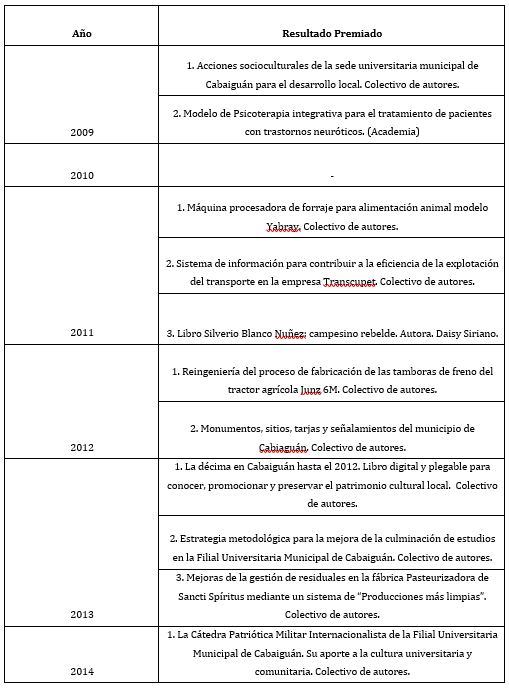Contribution of Award-Winning Research to the Visibility of Science on a University by Raquel de la Cruz Soriano in Open Access Journal of Biogeneric Science and Research
ABSTRACT
This article presents the experience in the preparation and presentation of results to the call for awards of the Ministry of Science, Technology and Environment, evidence of the impact achieved. The methods of science were applied such as: analysis and synthesis, historical and logical, hypothetical deductive; within the empirical ones: observation, document review, interview, training actions, conducting scientific sessions, giving conferences and joint elaboration. The scientific results with the potential to opt for the call were determined by reviewing documents, interviewing teachers-researchers, holding scientific sessions on the subject and giving lectures on the methodological procedure.
KEYWORDS: Science and Technological innovation; Prizes; Scientific results.
Introduction
This article highlights one of the indicators of the Science, Technology and Innovation process as one of the pillars of the management of substantive processes in municipal university centers. As innovation is a social process, the inadequacies of the educational system and high levels of poverty and social inequality affect the development and performance of innovation systems. The links between universities and public Research + Development (R + D) centers, with the productive sector, are mostly based on obtaining information and training and not on forms of interaction to reverse specific problems, through the application of results. scientists, that is, closing the research cycle [1]. The evaluation of the impact of science and technology constitutes a strategic need, as a way to verify the development of a country, its scientific policy, as well as its management in terms of society and the human beings who live in it [9]. Given the new development perspectives depending on the local, [8] indicates the need for greater integration of the Municipal University Centers with the productive sector, increasing the connections between the different actors outside the municipality, which enhances the development of the learning and innovation, from the increase of the scientific debate in the locality, which means increasing the rigor in the analysis of the problems [7]. sustains that the research bases a broad innovation approach or “DUI innovation mode” (doing, using, interacting) in which learning is key [5-6]. He argues in favor of innovation systems that favor social inclusion and care for the environment. Technological trajectories should benefit the human groups involved, expand their knowledge, improve their quality of life, among others [3].
Achieving relevance in science and technology has its starting point in the needs of economic, social and cultural development of the territory, these guide the substantive processes of science, technique and postgraduate that are executed in the Municipal University Centers (CUM); In these, the search is encouraged based on the need to possess knowledge and they drive action. The learning needs determine the high-level continuing training activities, based on the demand of the group of professionals graduated from a territory, who become the main clients of the postgraduate studies of their university. This activity enhances interaction with the university environment and provides new knowledge to those involved in research and development projects, in turn, it is a search for new research needs and opportunities, research projects; so that an ascending cyclical and interactive process is established.
On many occasions, quality in education centers has been related to terms such as: prestigious centers or centers of excellence, certified or accredited, with good economic resources and good infrastructures or good facilities, centers with excellent academic results, with good teachers and great leaders, with the satisfaction of parents and students and with evaluation of all kinds: of the system, of the educational processes, of the results.
As part of the dynamics of science and technological innovation management, the scientific visibility indicators express the relevance and relevance of the research results. That is why achieving territorial recognition is a goal of the Cabaiguán CUM, an aspect that has been projected in the strategic planning of the institution in different stages, which has required the execution of different training actions for the faculty.
This article proposes to expose the experience in the preparation and presentation of results to the call for awards of the Ministry of Science, Technology and Environment, evidence of the impact achieved.

Figure 1: Mapa de proceso, tipo de proceso: Ciencia e Innovación Tecnológica. Fuente: FUM (2014) b)


Figura2: Diagrama de flujo del proceso de Ciencia e Innovación Tecnológica. Fuente: elaboración propia.
Table1: Premios otorgados por el CITMA (2009-2020)

Table2: Trabajos premiados por el CITMA.



Conclusion
The increase in results in the calls made as of 2012 is significant, determined mainly by the results of investigations of teachers in the completion of master's thesis, the completion of study of undergraduate students, innovations in companies in the territory and in university processes; as part of research projects or problem bank in local institutions. The experience presented shows the viability of the flow diagram for the management of science and innovation in a university campus, where the training carried out to the faculty and the method of joint preparation of the files to be presented to the awards calls, allow materialize presented results.
More information regarding this Article visit: OAJBGSR
https://biogenericpublishers.com/pdf/JBGSR.MS.ID.00247.pdf
https://biogenericpublishers.com/jbgsr-ms-id-00247-text-2/

No comments:
Post a Comment